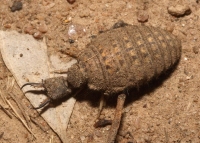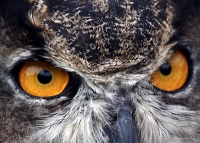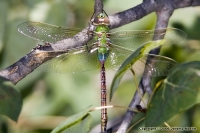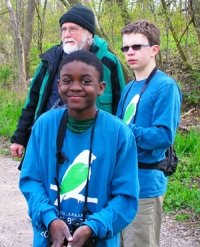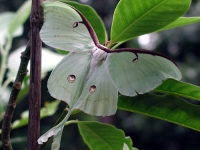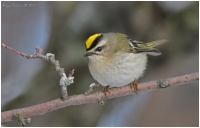

Jennifer Callaghan
Jennifer came to Wisconsin later in life, but has fully embraced the great state of Wisconsin as home. Her first career was as a professional ballet dancer, but a lifelong passion for nature and animals led her to a second career in environmental biology. She loves to learn new things and share her love of nature with others. In her free time she likes to travel and stay active with her awesome husband and sweet little dogs.
Native Animal of the Month: Dark-eyed Junco
I recently pre-screened a copy of the Ordinary Extraordinary Junco in preparation for an April family program*. The film truly was fascinating and while I have always liked the little junco (especially when it is one of the only birds around on winter bird walks), my appreciation for them grew even more after having watched the film. The rapid adaptation that juncos are undergoing as a species and their unbridled tenacity make them a really neat bird.
Native Animal of the Month - The Ant Lion
During our recent bout of sub-zero weather, I noted the shortage of wildlife in my backyard. I knew that woodchucks were hibernating in cozy burrows, birds had insulating feathers, and turtles used anti-freeze in their blood to get through the winter, but then I considered our spineless friends. Surely all of Earth's 1.3 million invertebrate species couldn't move inside for the winter. But, where did they go? This question made me think about one bug in particular; one that I commonly associate with the warm weather. The antlion. What was my old buddy Mr. Ant Lion up to this time of year?
Native Animal of the Month - Woodchuck
What?! No article about prancing reindeer or beautiful red cardinals?! I know, I know, but hear me out. I wanted to recognize an animal this month that we don't necessarily see in the winter, yet is living right under our feet. You may not see the woodchuck around this time of year, but he is still there fighting the good fight, hiding inconspicuously beneath the ground's surface. And hey, perhaps Santa wouldn't have needed Rudolph to guide him through the dark if his sleigh had been tethered to 8 mighty woodchucks instead of 8 tiny reindeer. But, I digress. Happiest of holidays to you all. Now, just imagine the woodchuck with a tiny jingle bell collar and glittery snow sprinkled atop his pelt. It already seems more seasonally appropriate, doesn't it?
Native Animal of the Month - Aerial Yellowjacket
As the seasons change from autumn to winter, my field work tapers off and I spend most of time behind a computer, analyzing data and determining what can be accomplished the following field season. During this period our bird walks become my favorite time of the week. The walks give me some personal time to identify with nature be outside. However it isn’t the birds I enjoy the most, it’s the other discoveries. I like finding the overlooked, under-appreciated things that just seem beautiful and you can't really explain why. This week, my favorite find came while I was on a bird walk in the Menomonee Valley.
The Great Horned Owl: Shining a Light on a Shadowy Creature
Imagine a stroll through the forest on a cold October evening. As you make your way down the path, a haunting call stops you in your tracks. The clouds part and the moonlight reveals a large shadow perched on a gnarled branch. The shadow regards you with piercing yellow eyes, then leaps from its roost and flies off silently into the darkness. You’ve just had a breathtaking encounter with a Great Horned Owl.
Native/Non-Native Animal of the Month - Mole Cricket
One of my favorite parts of summer is the unique sounds of insects and in particular the song of the mole cricket. Many people confuse the mole cricket’s song with that of a frog, however, its staccato repeated chirps undeniably belong to an insect. The song’s frequency is very low for a bug and is known to be the lowest of all of the crickets.
Native Animal Spotlight - The Common Green Darner Dragonfly
The Common Green Darner (Anax junius) is a lovely migratory dragonfly that visits Wisconsin from April through September. This native invertebrate is Wisconsin's most common large dragonfly. The male has a bright bluish-green abdomen and is sexually dimorphic from the female whose abdomen ranges from brick-red to bluish gray. They have four gossamer wings, heavy thoraxes and are about the size of hummingbirds. They are extraordinary fliers; flying forward, backward, while mating and even while laying eggs! Their flight is so incredible that aeronautic scientists have studied them to better understand flight physics.
Green Birding Challenge 2013: A Huge Success!
The Green Birding Challenge is a friendly birding event to celebrate International Migratory Bird Day (IMDB) and raise money for Community Science programming at the Urban Ecology Center. We had 12 teams compete in four categories (walking, sitting, biking, and a mini-challenge). Teams recorded 112 species of birds and raised over $4800. This year, 10 Young Scientists from Washington and Riverside Park participated in the mini-challenge! Winners received trophies and experiential trips (canoe trip, hawk-watching trip, etc.) and the team with the fewest birds found received a free trip with the research team to work on bird identification skills.
Native Animal of the Month - The Luna Moth
The beautiful luna moth (Actias luna) is a large white-bodied moth, with lime green-colored wings and pinkish legs. This Wisconsin native is found in the state from spring to summer and flies only in the evenings. It has a wingspan of 3-5 inches and possesses a single transparent eyespot on each wing meant to confuse predators. Hind wings have long curved tails, giving the moth its distinct look.
Native Animal of the Month - Golden-crowned Kinglet
The tiny Golden-crowned Kinglet (Regulus satrapa) is one of the first migrants to arrive to Wisconsin in the spring. It gets its name from the beautiful orangish-yellow feathers on the top of its head which resemble a crown. The male's crown is a deeper orange, while the female's is more of a bright yellow. The crowns of both species are lined in black and underlined with a white eyebrow. The head pattern and pale underparts distinguish this bird from the plain face and yellower underparts of the Ruby-crowned Kinglet.
Copyright © 2023 The Urban Ecology Center


